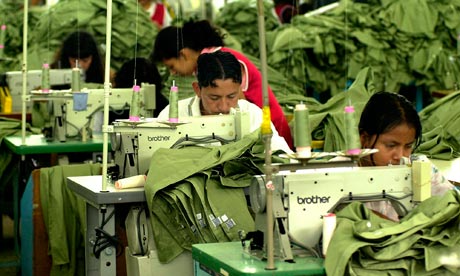Sweatshops are factories were workers get very low wages, have to work long hours, work in poor, dangerous conditions, exploited and many not allowed to speak out or join a trade union. Sweatshops are widespread throughout Asian countries however there are sweatshops in parts of Europe and The United States. Lots of the factory workers end up having to accept work in sweatshops or they would face extreme poverty.
 |
| Sweatshop |
China has the largest cotton/textile industry in the world. If you look at the clothes in your wardrobe the majority of them are made in China. To cope with the western demands China has to employ many workers. Shenzhen has both benefited and has been at an advantage because of this. 50 years ago Shenzhen was a small fishing village bordering Hong Kong. Over the years Shenzhen has changed dramatically. Now it is home to ten million people, most of them who are migrants from other parts of China. The Guandong Province (Where Shenzhen is situated.) has a booming economy that accounts for half of Chinas GDP.
 Li Chun Mei like any other Shenzhen citizen is employed as a toy factory
worker. Normally she would work past midnight despite of Chinas law that says workers
can’t work for more than eight hours. Sadly she died after a sixteen hour shift.
Her roommate found her on the bathroom floor of their dormitory with blood
pouring out of her mouth and noise. The factory manager blamed her death on a
motorcycle accident that took place previously though her death was on the premise
of the factory.
Li Chun Mei like any other Shenzhen citizen is employed as a toy factory
worker. Normally she would work past midnight despite of Chinas law that says workers
can’t work for more than eight hours. Sadly she died after a sixteen hour shift.
Her roommate found her on the bathroom floor of their dormitory with blood
pouring out of her mouth and noise. The factory manager blamed her death on a
motorcycle accident that took place previously though her death was on the premise
of the factory. Many of our high-street brands use sweatshops so they can supply the
consumer with cheap clothes. Workers in Bangladesh stitching Primark garments, earn
so little they cannot eat properly. Some workers are even malnourished. Primark
a leading high street brand after allegations on bad conditions of sweatshops
set up a website ‘Ethical Primark’. War on Want claimed its latest evidence
showed there is no difference in the lives of the workers due to Primarks’ new
website.
Many of our high-street brands use sweatshops so they can supply the
consumer with cheap clothes. Workers in Bangladesh stitching Primark garments, earn
so little they cannot eat properly. Some workers are even malnourished. Primark
a leading high street brand after allegations on bad conditions of sweatshops
set up a website ‘Ethical Primark’. War on Want claimed its latest evidence
showed there is no difference in the lives of the workers due to Primarks’ new
website. Workers are paid by garment made not by hour this way of payment means workers have to work long, hard hours. Primark’s code of conduct state that workers should have a maximum working time of 48 hours a week but workers say they work up to 84 hours. The workers said the conditions are appalling. They say there is no safe water to drink and the toilets are dirty. Few workers in these conditions can speak out as women and immigrants are banned from joining trade unions. We would think Governments would do something about this but they have little economic power compared to this big cooperation’s.
 We have to understand that these workers have a better life that they
are working though the conditions are bad. To solve these problems companies should
be open about their overseas labour so the consumer knows and how their clothes
are made. Countries should enforce their laws on wage and working hours by having
regular inspections on the factories. If we really knew how our clothes were
made we would have a different outlook on the clothes industry. The companies
are not the only ones to blame some of that lies on us. Our demand on cheap
clothes meant companies meant they had to find cheap labours so they could still
increase their profits and supply us with our need for clothes.
We have to understand that these workers have a better life that they
are working though the conditions are bad. To solve these problems companies should
be open about their overseas labour so the consumer knows and how their clothes
are made. Countries should enforce their laws on wage and working hours by having
regular inspections on the factories. If we really knew how our clothes were
made we would have a different outlook on the clothes industry. The companies
are not the only ones to blame some of that lies on us. Our demand on cheap
clothes meant companies meant they had to find cheap labours so they could still
increase their profits and supply us with our need for clothes.
No comments:
Post a Comment